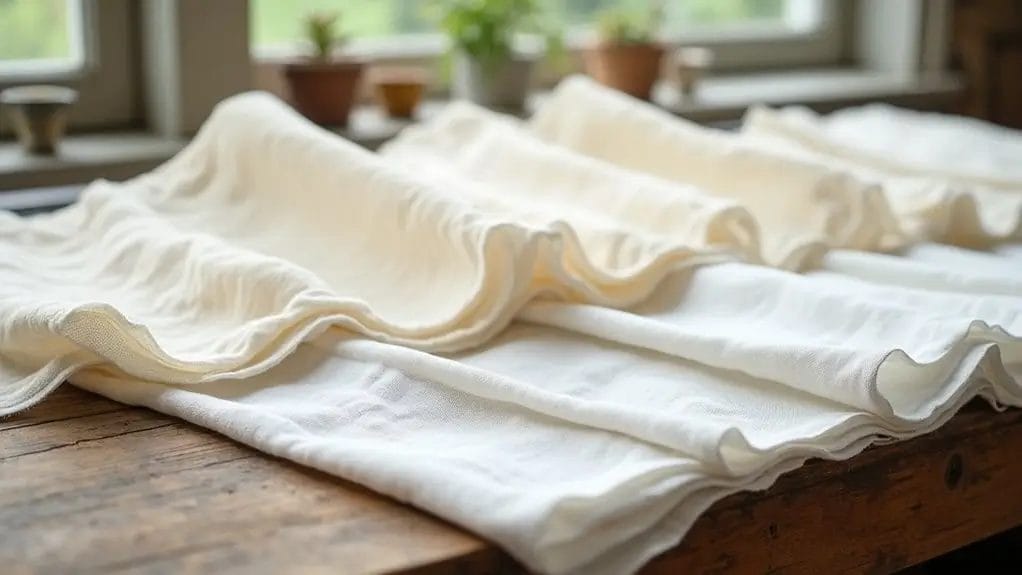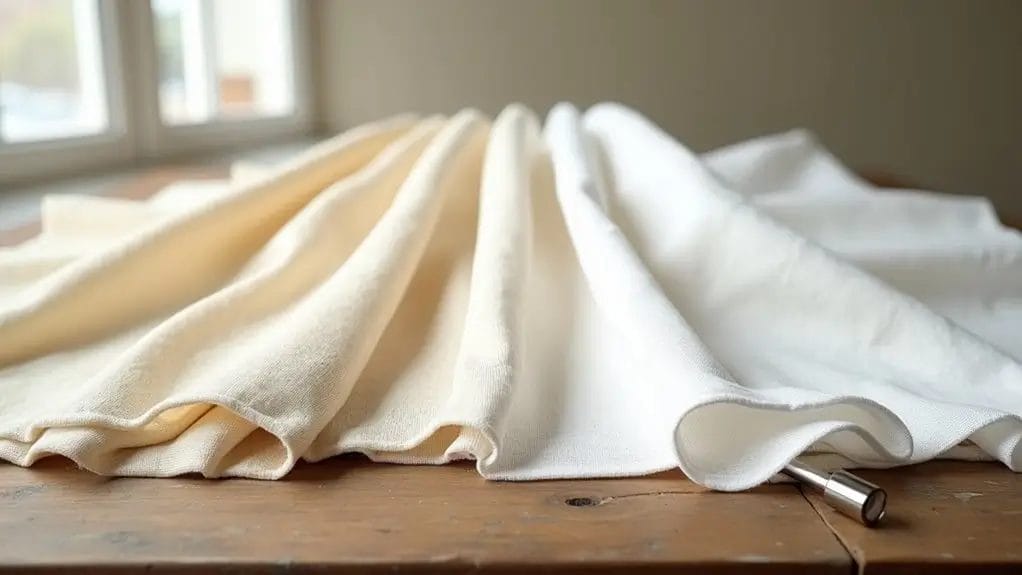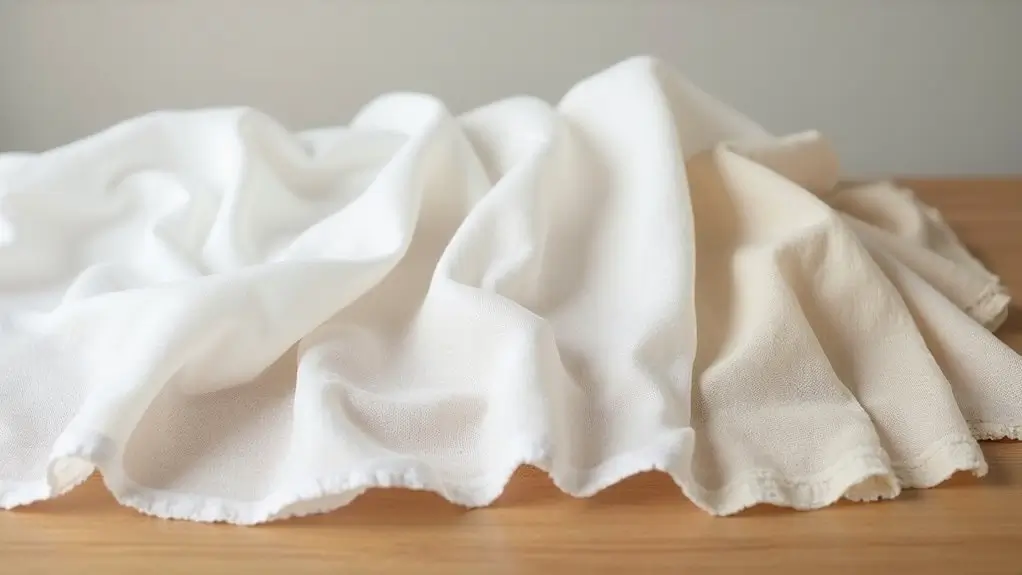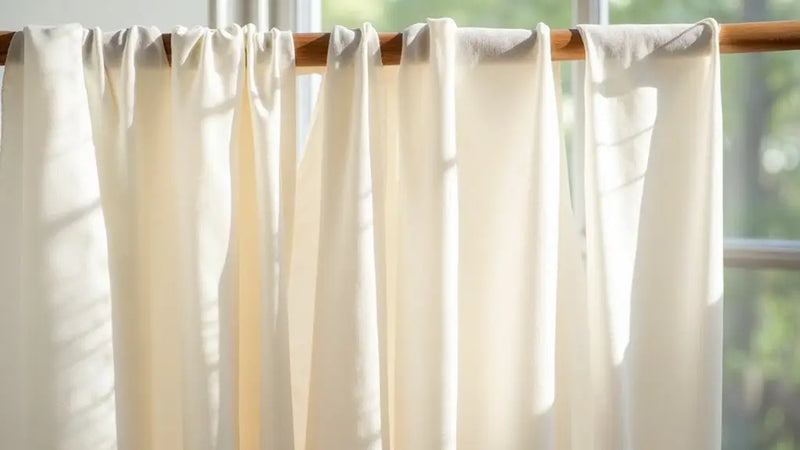Muslin fabric comes in several distinct grades tailored to specific uses. Premium grade offers 200+ thread count for high-end fashion. Basic craft grade suits practice projects and mock-ups.
You'll find specialized varieties like medical grade for healthcare, photography grade for backdrops, and cheese grade for food production.
Each type of muslin fabric features unique characteristics in weave density, texture, and durability. Understanding these differences will help you select the perfect muslin for your next project.
Key Takeaways
- Premium grade muslin features a 200+ thread count and ultra-smooth texture. It's ideal for high-end fashion and professional photography backdrops.
- Basic craft grade muslin offers an affordable option with looser weave. It's perfect for practice sewing and costume mock-ups.
- Medical grade muslin meets strict quality controls with hypoallergenic properties. It's specifically designed for healthcare applications like gauze and dressings.
- Bleached and unbleached muslin serve different purposes. Bleached is ideal for baby clothes, and unbleached is best for mock-ups.
Types of Muslin Fabric: The Different Grades Explained

When you're shopping for muslin, you'll find it comes in distinct quality grades. Three distinct quality grades define the market standard for muslin cloth: premium, standard, and utility grade.
Premium Grade Muslin Quality
Premium grade muslin quality stands out with its exceptional thread count of 200 or higher. It creates an incredibly smooth and refined texture that you'll notice immediately upon touch. This highest-grade cotton muslin is tightly woven with superior long-staple cotton fibers.
You'll find premium-grade muslin fabric used in high-end fashion, luxurious baby products, and professional photography backdrops. Its superior durability and softness make it worth the higher price point.
Basic Craft Grade Muslin
Basic craft grade muslin represents the most affordable and widely available quality level in the muslin fabric family.
You'll find this cotton fabric often used for test garments and crafting projects. This is due to its low cost and basic functionality.
While it's still a breathable fabric, basic craft grade muslin features a looser weave and rougher texture than higher-quality varieties.
You can identify low-quality muslin by its slightly irregular threads and occasional small knots in the weave.
Quilting Grade Features
Quilting-grade muslin offers considerably higher quality than basic craft varieties. It features a tighter weave and more uniform thread consistency. This muslin fabric has fewer imperfections. It maintains its shape better during repeated washings.
When working with quilting-grade muslin, you'll enjoy its lightweight yet durable fabric.
The different types of muslin in this category provide excellent absorbent properties. These properties make them ideal for intricate quilting projects.
This grade is perfect for quilt backing, testing patterns, and creating heirloom-quality pieces.
Sheeting Grade Characteristics
Sheeting-grade muslin delivers exceptional strength and durability. It's a top choice for home decor and theatrical purposes.
This cotton fabric variant is tightly woven and thicker than standard muslin. It offers superior stability and structure. You'll find muslin sheeting commonly used for stage backdrops, curtains, and upholstery projects.
Though it's heavier than other muslin fabrics, it still maintains breathability. The fabric's sturdy construction allows for excellent paint adhesion and detailed printing.
Cheese Grade Muslin Uses
Cheese-grade muslin serves a specialized purpose in dairy production and cheese making. This unbleached muslin is specifically designed with an open, loose weave. It allows whey to drain while containing the curds during cheese production.
When working with cheese-grade muslin, you'll find it to be both lightweight and durable. It can handle repeated use and washing.
The fabric's natural cotton fibers help maintain proper moisture levels. This is important during the aging process. Meanwhile, its breathable nature prevents unwanted bacterial growth.
Theatrical Backdrop Grade
Three main grades of theatrical backdrop muslin are key for stage design: lightweight, medium-weight, and heavyweight.
- Lightweight muslin fabric is perfect for creating ethereal effects. It also allows light to filter through.
- Medium-weight fabric offers versatility for standard backdrops and painted scenes.
- Heavyweight muslin provides the most durability and opacity. This cotton fabric grade features enhanced absorbent properties. These properties help it hold paint exceptionally well.
Apparel Grade Specifications
In the vast world of textiles, apparel-grade muslin comes in distinct quality levels. Each level serves different purposes in garment making.
| Grade | Thread Count | Best Used For |
|---|---|---|
| Premium | 200+ | Final garments |
| Standard | 150-200 | Test fits |
| Basic | 100-150 | Pattern making |
| Economy | 60-100 | Draping |
| Utility | Below 60 | Interfacing |
Medical Grade Standards
Medical-grade muslin meets strict quality controls set by healthcare regulators worldwide. These standards are particularly stringent for gauze and medical dressing pads.
When choosing medical-grade muslin, look for certification that proves it is hypoallergenic and absorbent.
The fabric must maintain its lightweight characteristics. It also needs to meet specific threading requirements for medical use.
Industrial Grade Properties
Industrial-grade muslin offers distinct properties that set it apart from other grades. This form of muslin is made from cotton using a tighter weave and stronger threading. These make it more durable for heavy-duty applications.
Industrial muslin is known for its superior tensile strength and resistance to wear. It's thicker than standard muslin fabric, typically ranging from 200 to 300 thread count.
During muslin production, manufacturers add treatments to make it stronger and more heat-resistant.
Photography Backdrop Grades
Professional photographers use three muslin backdrop grades: economy, medium, and premium.
- Economy grade muslin fabric offers basic functionality. It features a thinner, lightweight construction that's ideal for beginners or temporary setups. You'll notice some visible texture and potential wrinkles.
- Medium-grade photography backdrops provide better color absorption and wrinkle resistance. They're suitable for regular studio use.
- Premium-grade muslin delivers the highest quality. It owns seamless construction, superior dye retention, and minimal maintenance needs. This breathable fabric holds up beautifully under studio lights.
Common Uses for Each Muslin Type

Each muslin fabric type serves different purposes. This is based on its unique features and construction.
- Bleached muslin: Perfect for baby clothes, summer dresses, and quilting projects.
- Unbleached muslin: Ideal for garment mock-ups, theater backdrops, and furniture covers.
- Gauze muslin: Excellent for bandages, lightweight scarves, and window treatments.
- Colored or patterned muslin: Great for decorative crafts, costumes, and home décor projects.
These versatile fabrics adapt well to your specific needs. They're suitable for sewing, crafting, and working on professional projects.
Characteristics of Premium vs. Standard Muslin

Understanding the differences between premium and standard muslin can help you make better decisions.
Premium muslin is made with longer cotton fibers and higher thread counts. This results in a softer, more durable fabric that's less prone to pilling. It offers superior draping and color retention.
Standard muslin has shorter cotton fibers and lower thread counts. This makes it more affordable but slightly coarser. It's perfectly suitable for everyday projects like pattern testing and basic photography backdrops.
The price difference reflects these varying characteristics of muslin quality levels.
Manufacturing Methods and Their Impact on Quality

Manufacturing techniques greatly influence the quality of muslin. So understanding these methods can help you choose the right fabric for your needs.
- Traditional handloom weaving creates premium muslin fabric with higher thread counts. So it features superior durability.
- Machine-made versions offer more affordable options.
- Organic cotton muslin is produced without synthetic chemicals. This results in a purer, lightweight fabric that's gentler on sensitive skin.
Modern manufacturing methods include mechanical spinning, power looms, and automated finishing processes.
These processes make muslin more accessible. But usually they result in fabric with lower thread counts than handwoven types.
How to Choose the Right Muslin for Your Project

Choosing the right muslin fabric begins with knowing your project's needs. You'll need to evaluate factors like weight, texture, and finish based on your intended use.
| Project Type | Recommended Muslin | Key Features |
|---|---|---|
| Baby Items | Bleached Cotton | Soft, hypoallergenic |
| Photography | Heavy Unbleached | Durable, non-reflective |
| Clothing Test | Medium Weight | Cost-effective, easy to mark |
| Home Decor | Swiss Muslin | Decorative, structured |
| Medical Use | Gauze Muslin | Ultra-lightweight, sterile |
Bleached options work better for finished products. But unbleached varieties are ideal for test garments and crafts. Also, assess your fabric's care requirements. You can wash muslin in a machine, but delicate varieties need gentle handling.
Conclusion
Now that you know about different muslin fabrics, you can better choose the right one for your needs. Whether making a test garment, home décor, or sewing project, consider the grade, weight, and finish that fit your needs.
Don't hesitate to request samples before making a larger purchase. Experiencing the fabric firsthand will help ensure you're making the right choice.
Learn more fabric knowledge on the Longan Craft Blog, and dive into the fabric world with Longan Craft!
FAQs
Can Muslin Fabric Be Used for Outdoor Furniture Covers?
You shouldn't use muslin for outdoor furniture covers. Because it's not water-resistant and can easily deteriorate when exposed to weather. Instead, choose weather-resistant fabrics like polyester or canvas for better protection.
How Does Muslin Compare to Linen in Terms of Longevity?
While both fabrics are durable, you'll find linen typically outlasts muslin. Linen's stronger fibers make it more resistant to wear and tear, becoming softer over time. But muslin's lighter weave wears down faster.
Does Muslin Fabric Attract Moths and Other Fabric-Damaging Insects?
Yes, because it's made from natural cotton fibers. However, you can protect your muslin by storing it with cedar blocks or mothballs.
Can Muslin Be Effectively Waterproofed While Maintaining Its Breathability?
You can waterproof muslin using fabric waxes or water-repellent sprays. But it'll only provide moderate protection while maintaining some breathability. For full waterproofing, you'll sacrifice most of muslin's breathable qualities.
What Causes Muslin Fabric to Yellow Over Time?
Your muslin fabric can yellow because of exposure to sunlight, oxidation, improper storage, body oils, and environmental pollutants. You'll notice this especially in unbleached muslin that's not properly cleaned or stored.


0 comments